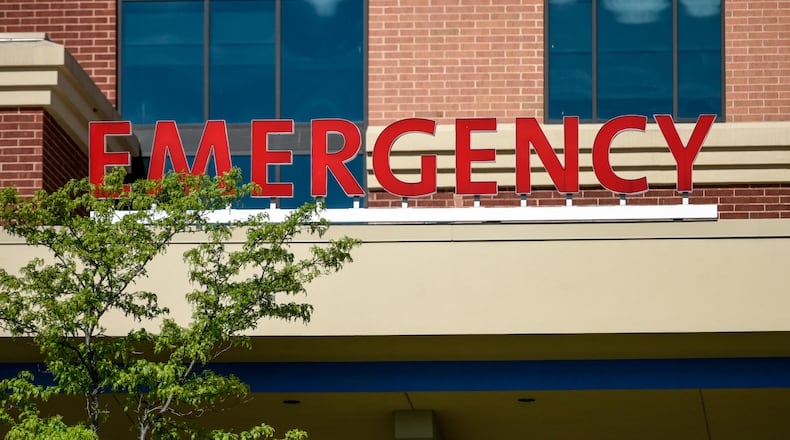Tim Schoonover, medical director for Kettering Health Network Stroke Program, said the network has seen about a 30% decline since late March in strokes, though patient counts have started to trend back up in recent weeks. He said the decline has been across ages and sexes and while providers don’t know for sure why, they think people are staying at home because they are afraid.
“Obviously, it’s really unexpected. No one really expected this to happen. It’s pretty alarming and concerning because these are emergency problems,” Schoonover said.
Premier Health and Kettering Health Network both noted significant drops in stroke and other cardiac emergency patients at their ERs since the start of the coronavirus outbreak as well as a general drop in emergency visits, with anecdotes of patients hesitant to seek care for illness and injury.
Hospitals and practices in the region aren’t the only ones noting this drop. A preliminary analysis of nine U.S. hospitals – including The Christ Hospital in Cincinnati — found significant drops in patients treated for severe heart attacks in March compared to the 14 months leading up to the epidemic.
Delays in care for cardiac emergencies can mean more damaged tissue, while immediate treatment can minimize the long-term effects of a stroke and even prevent death.
Some people might be ignoring signs of mini strokes, which can mean missing to prevent a future stroke.
“TIAs (transient ischemic attacks) or mini strokes, typically we view them as the warning signs for a larger event later on,” Dr. Darin Pangalangan, chair of Premier Health’s Emergency and Trauma Institute, said.
About 1 in 3 people who has a transient ischemic attack will eventually have a stroke, according to Mayo Clinic.
“Folks are not getting the treatment that they could get. And therefore their symptoms are very likely to persist and be worse and functional outcomes will be worse relative to those who are still coming in,” Schoonover said.
Schoonover said he’s talked with patients who have come in days after having symptoms who said they were hoping the symptoms would go away so they didn’t have to go to the hospital.
He said they also think older people could be isolated and having symptoms by themselves and no one there to notice symptoms.
“So if they have a slurred speech or some weakness or numbness and they’re not really identifying those and they’re not having family members over who will identify them, because often the family member identifies stroke symptoms,” Schoonover said.
Ohio hospitals had previously suspended many surgeries and procedures, not because hospitals were declared unsafe but because they were struggling to order supplies of more masks, gowns and gloves and also needed to clear out rooms for a projected surge in patients. When Ohioans flattened the curve from original projections and the rate of spread slowed, with more protective equipment secured as well, hospitals started to resume more procedures.
As of May 1, hospitals and medical offices were able to schedule procedures and surgeries that do not require an overnight stay. On May 18, hospitals in the 11-county region surrounding Dayton — in Auglaize, Butler, Darke, Champaign, Clark, Greene, Miami, Montgomery, Preble, Shelby, and Warren counties — changed pandemic visitor restrictions to allow more people to have a visitor, though under limited circumstances and with screening and new mask requirements.
Mike Abrams, president and CEO, Ohio Hospital Association, said many procedures were originally halted because of the need to keep hospital beds empty for a possible COVID-19 surge and to preserve the personal protective equipment hospitals use to keep you and your treatment team safe. It is safe to receive care at hospitals and people need to seek appropriate medical care, he urged.
“Emergency care and procedures necessary to assure a medical condition did not progress or result in permanent damage were not postponed by our COVID-19 response. It is imperative you do not defer these procedures now. For example, a cardiac catherization would not have been ordered for you if your doctor did not believe there was a significant issue to be treated,” Abrams said in a statement about not delaying care.
Pangalangan said Premier hospitals have a team meeting daily and when new recommendations come out, they are implementing them.
Some of these measures include that Premier has a split flow system is in effect at all emergency departments and patients who exhibit symptoms associated with COVID-19 are separated from those who do not.
Patients with COVID-19 symptoms are treated in designated areas separate from patients with other medical emergencies. Visitor restrictions are in place and enforced. The waiting room seating allows for proper distancing. All patient-facing and non-patient facing staff are wearing face coverings.
Patients and any companions are required to wear masks when present at Premier Health’s sites of care, provided either by themselves or by the site of care. Significant steps have been taken to ensure an adequate supply of COVID-19 testing and the movement to universal testing at all Premier Health hospitals.
“We have a large list of safety measures in place,” Pangalangan said.
Warning signs
If you are having a sign of a stroke or a heart attack, call 911.
Some signs of a heart attack include: Chest pain; difficulty breathing; or discomfort in the chest, arms, back, neck, shoulder or jaw.
Some signs of a stroke include: Numbness, weakness or loss of movement in the face, leg, or arm, especially on one side; confusion, trouble speaking or understanding; or loss of balance.
Source: Premier Health
About the Author
